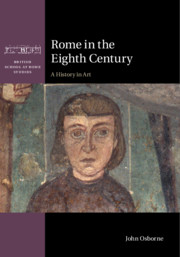Refine search
Actions for selected content:
23990 results in Ancient history
Introduction
-
- Book:
- The Fragmentary Latin Histories of Late Antiquity (AD 300–620)
- Published online:
- 04 June 2020
- Print publication:
- 25 June 2020, pp 1-27
-
- Chapter
- Export citation
16 - Marcellinus Comes
-
- Book:
- The Fragmentary Latin Histories of Late Antiquity (AD 300–620)
- Published online:
- 04 June 2020
- Print publication:
- 25 June 2020, pp 182-193
-
- Chapter
- Export citation
1 - Carminius
-
- Book:
- The Fragmentary Latin Histories of Late Antiquity (AD 300–620)
- Published online:
- 04 June 2020
- Print publication:
- 25 June 2020, pp 28-31
-
- Chapter
- Export citation
4 - Nummius Aemilianus Dexter
-
- Book:
- The Fragmentary Latin Histories of Late Antiquity (AD 300–620)
- Published online:
- 04 June 2020
- Print publication:
- 25 June 2020, pp 59-63
-
- Chapter
- Export citation
14 - Symmachus the Younger
-
- Book:
- The Fragmentary Latin Histories of Late Antiquity (AD 300–620)
- Published online:
- 04 June 2020
- Print publication:
- 25 June 2020, pp 146-165
-
- Chapter
- Export citation
23 - Tyconius
- from Spuria et Dubia
-
- Book:
- The Fragmentary Latin Histories of Late Antiquity (AD 300–620)
- Published online:
- 04 June 2020
- Print publication:
- 25 June 2020, pp 264-267
-
- Chapter
- Export citation
13 - Ablabius
-
- Book:
- The Fragmentary Latin Histories of Late Antiquity (AD 300–620)
- Published online:
- 04 June 2020
- Print publication:
- 25 June 2020, pp 137-145
-
- Chapter
- Export citation

Rome in the Eighth Century
- A History in Art
-
- Published online:
- 11 June 2020
- Print publication:
- 09 July 2020
Bibliography
-
- Book:
- Roman Cult Images
- Published online:
- 15 May 2020
- Print publication:
- 11 June 2020, pp 321-346
-
- Chapter
- Export citation
Four - Idols at Home
-
- Book:
- Roman Cult Images
- Published online:
- 15 May 2020
- Print publication:
- 11 June 2020, pp 146-195
-
- Chapter
- Export citation
Notes
-
- Book:
- Roman Cult Images
- Published online:
- 15 May 2020
- Print publication:
- 11 June 2020, pp 291-320
-
- Chapter
- Export citation
Five - Idols in Action
-
- Book:
- Roman Cult Images
- Published online:
- 15 May 2020
- Print publication:
- 11 June 2020, pp 196-221
-
- Chapter
- Export citation
Appendix
-
- Book:
- Roman Cult Images
- Published online:
- 15 May 2020
- Print publication:
- 11 June 2020, pp 281-290
-
- Chapter
- Export citation
Seven - Conclusion
-
- Book:
- Roman Cult Images
- Published online:
- 15 May 2020
- Print publication:
- 11 June 2020, pp 272-280
-
- Chapter
- Export citation
Two - The Birth of Cult Images
-
- Book:
- Roman Cult Images
- Published online:
- 15 May 2020
- Print publication:
- 11 June 2020, pp 24-84
-
- Chapter
- Export citation
Acknowledgments
-
- Book:
- Roman Cult Images
- Published online:
- 15 May 2020
- Print publication:
- 11 June 2020, pp xiii-xiv
-
- Chapter
- Export citation
Copyright page
-
- Book:
- Roman Cult Images
- Published online:
- 15 May 2020
- Print publication:
- 11 June 2020, pp iv-iv
-
- Chapter
- Export citation
Tables
-
- Book:
- Roman Cult Images
- Published online:
- 15 May 2020
- Print publication:
- 11 June 2020, pp xi-xii
-
- Chapter
- Export citation
Index
-
- Book:
- Roman Cult Images
- Published online:
- 15 May 2020
- Print publication:
- 11 June 2020, pp 347-358
-
- Chapter
- Export citation
Six - The End of Idols
-
- Book:
- Roman Cult Images
- Published online:
- 15 May 2020
- Print publication:
- 11 June 2020, pp 222-271
-
- Chapter
- Export citation
